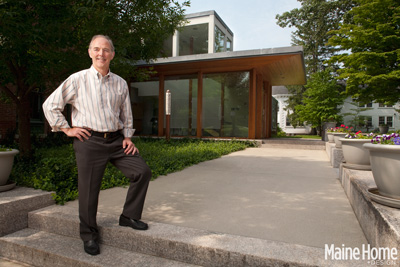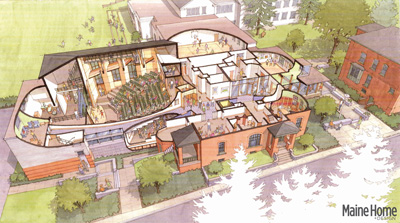Blending New with Old

AIA DESIGN THEORY-September 2010
Edited by Rebecca Falzano
Photography Trent Bell
Architect Scott Simons is at the intersection of historic and modern
 Architects in Maine are often asked to renovate and add onto historic buildings. Scott Simons, of Scott Simons Architects in Portland, has had the opportunity to design many modern buildings in historic contexts. The Waynflete Arts Center, in the center of the Western Promenade Historic District, is a good example of this. We asked Scott how he went about designing this building and how he was able to achieve a balance between the modern additions and their historic context.
Architects in Maine are often asked to renovate and add onto historic buildings. Scott Simons, of Scott Simons Architects in Portland, has had the opportunity to design many modern buildings in historic contexts. The Waynflete Arts Center, in the center of the Western Promenade Historic District, is a good example of this. We asked Scott how he went about designing this building and how he was able to achieve a balance between the modern additions and their historic context.
Q: How did you approach the design of the Arts Center project?
A: From the start, we wanted to design a very modern building to reflect the progressive nature of the arts programs the school would be teaching in the building. The school is in a neighborhood of beautiful brick homes, and there was a lot of fear that the modern additions would be disruptive to the historic fabric of the neighborhood. We studied the pattern of development and discovered there was a rhythm of brick buildings and open, green spaces that helped create the character of the neighborhood. Once we understood this, we were able to plan the new additions to reinforce the pattern, pushing the more modern, glass portions of the building back from the street with green space in front of them, and pulling the more solid brick portions of the building out to align with the brick houses on either side. As you walk down the streets in the neighborhood, the pattern of development is reinforced; the modern architecture of the additions blends into the pattern of the green spaces.
Q: The project also included extensive renovations to some existing buildings. How did you design the modern additions so they would blend with these historic buildings?
A: It was important to understand the organizational structure of the historic buildings we were adding onto. It turns out there was an underlying proportional system that determined the placement of windows, ratios of heights to widths, and so on. Once we discovered this system, we simply related the new to the old using these ratios so they would harmonize with each other. The windows on the new additions are much larger than those on the historic buildings, but they are proportionately related to them. The roofs of the new additions are very different from the roofs of the historic buildings, but they are horizontally related and aligned in ways that they complement each other. Our eyes pick up on these details; we intuitively know when things look right. Duke Ellington said, “If it sounds good, it is good.” The same could be said about good architecture; if it looks good and feels good when you walk through it, then it is good.
Q: How did you actually connect the new to the old?
A: Our approach was to clearly articulate the difference between the new and the old. The materials of the new additions—large sheets of glass, engineered wood columns, and zinc-coated copper trim—are very different from the historic building they are connected to. We also were very careful about the way the new touches the old. Wherever the new abuts the old, there is a clear change of material, a clear change of intent, so there is no confusion about where the new addition starts and the old building ends.
Q: Do you think architects should advocate for more modern design?
A: Absolutely. It is important for architecture to be true to its time. There’s nothing worse than historic replicas, in my opinion. We don’t commission writers or musicians to create historic replicas, and we shouldn’t ask architects to create old-looking buildings. Modern architecture can enhance historic architecture. The contrast between old and new can be very exciting and informative. Architecture tells us a lot about the time when it was built. This is an exciting time to be alive and our architecture should reflect that. Portland is a great little city and it should have modern, progressive architecture that reflects the uniqueness of the people that live and work here.
Q: What are some other examples of your work that illustrate your approach?
A: We recently completed the renovations and additions to the Portland Public Library. The original building is historically important; it is considered the best example of the late International Style in the greater Portland area. We wanted to enclose the outdoor area in the front of the building, to bring the library spaces closer to the street and Monument Square. We also wanted the new space to be filled with sunlight, so it would a great gathering space for the people of Portland. We enclosed the space with a glass curtain wall. If you look closely you will see the new tubular steel structure holds the glass on the outside of the old building at the top and on the inside at the bottom, allowing the stone piers of the original building to come inside the new structure and then reappear on the outside again. The new touches the old very lightly; the new is clearly articulated so there is no confusion about what is old and what is new. One hundred years from now, people will understand something about what we were thinking in 2010—that we respected the past but wanted to do something new, something that expressed how we wanted to live today.